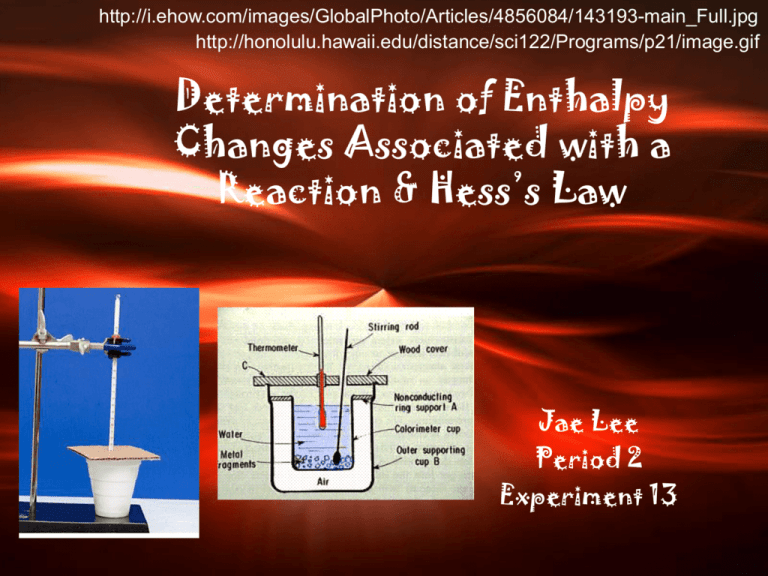Hess Law_Jae_09 - coolchemistrystuff
advertisement

http://i.ehow.com/images/GlobalPhoto/Articles/4856084/143193-main_Full.jpg http://honolulu.hawaii.edu/distance/sci122/Programs/p21/image.gif Determination of Enthalpy Changes Associated with a Reaction & Hess’s Law Jae Lee Period 2 Experiment 13 Background Information • Thermochemistry – study of heat chances & transfers associated with chemical reactions • Hess’s law states that at constant pressure, the enthalpy change for a process is not dependent on the reaction pathway, but is dependent only upon the initial and final states of the system. • ΔH is used to write the change in heat Equations you should know and will use.. • NaOH(aq) + HCl(aq) NaCl(aq) + H2O(l) • NH4Cl(aq)+NaOH(aq) NH3(aq)+NaCl(aq)+H2O(l) • NH3(aq) + HCl(aq) NH4Cl(aq) Purpose of Lab • To determine the enthalpy change that occurs when a strong base, NaOH (Sodium Hydroxide), reacts with a strong acid, HCL (Hydrochloric acid) http://www.hansatech-instruments.com/quantitherm.jpg Materials • A calibrated temperature probe • Thermometer • Calorimeter • Water • 2.00 M HCl • 2.00 M NaOH • 2.00 M NH4CL • 2.00 M NH3 http://wolfesscience.com/images/lab-thermometer.jpg More materials • Styrofoam cover • Polystyrene cups • 400 ml beaker • Glass Stirring Rod http://www.slsonline.co.uk/asps/uploads/big/2148-1.jpg http://www.crscientific.com/stir-rods.jpg •http://www.chem.ualberta.ca/~ngee/ExptG1.gif Procedure 1. 2. 3. 4. 5. 6. 7. 8. 9. Place 50.0 mL of room temp. distilled water in calorimeter Use calibrated temperature probe to determine/ record temperature Add 50.0 mL of warm distilled water to calorimeter Record temperature every 30 seconds for 3 min. Clean beaker for next experiment Measure temp chance water 50.0 ml of 2.00 M HCl is added to 50.0 ml of 2.00 M NaOH Record temperature change every 30 sec. for 3 min. Repeat step 7 but with 2.00 M NH4Cl with 2.00 M NaOH Repeat step 7 but with 2.00 M NH3 with 2.00 M HCl Analysis A graph of the heat capacity of the calorimeter. From the graph, determine the heat capacity of the calorimeter. The specific gravity of water at 23.0 C is 0.998 and at 61.0 C •Chart created from Experiment 13: Determination of Enthalpy Changes Associated with a Reaction and Hess’s law • Extrapolating the regression line to the Y axis (0 seconds) gives a temperature of 41.4 °C at the moment the room temperature and warm water were mixed • Average temperature of room temperature and warm water: • 23.0 °C + 61.0 °C = 42.0 °C 2 • Ccalorimeter = qcalorimeter (Tmix – Tinitial) • qcalorimeter = -qwater • Qwater = (mass water)*(specific heat)*(Tmix – Tavg) • At 23.0°C: 50.0 mL H2O x 0.983 g*mL-1 1 = 49.9 g H2O • At 61.0°C: 50.0 mL H2O x 0.983 g*mL-1 1 = 49.1 g H2O • Total mass = 49.9 g + 49.1 g = 99.0 g H2O =(99.0 g)*(4.18 J/g * °C)*(41.4°C – 42.0°C) = -2.5x102 J Heat gained by calorimeter = -qwater = 2.5x 102 J Ccalormeter = qcalorimeter 2.5 x 102 J = 14 J* °C (Tmix-Tinitial) (41.4 °C – 23.0 °C) (#2.) Temperature changes for each of the 3 reactions Calculate the heat evolved in the reaction (kJ/mol of product). Assume the density of each solution = 1.00gxmL-1 •Chart created from Experiment 13: Determination of Enthalpy Changes Associated with a Reaction and Hess’s law http://www.razor-gator.com/SkinAcidsPhotos/Bottle-HCl&NaOH.jpg (a) • HCl + NaOH qrxn = -[(masssol’n) x (specific heat sol’n) x (ΔTsol’n)] + (Ccalorimeter x ΔTsol’n) volumesol’n x molarity = [100g x 4.18J/g·°C x (3.56°C – 23.0°C)] + (14 J/°C x 12.5°C) 0.500L x 2.0 mole/L = . -5.4 x 103 0.0500L x 2.0 mol/L = - 54 kJ/mol (b) • NH4Cl + NaOH qrxn = -[(masssol’n) x (specific heat sol’n) x (ΔTsol’n)] + (Ccalorimeter x ΔTsol’n) volumesol’n x molarity = [100g x 4.18J/g·°C x (24.1°C – 22.9°C)] + (14 J/°C x 1.2°C) 0.500L x 2.0 mole/L = -5.2 x 102 J 0.0500L x 2.0 mol/L = - 5.2 kJ/mol . (c) • NH3 + HCl qrxn = -[(masssol’n) x (specific heat sol’n) x (ΔTsol’n)] + (Ccalorimeter x ΔTsol’n) volumesol’n x molarity = [100g x 4.18J/g·°C x (33.1°C – 23.0°C)] + (13.6 J/°C x 10.1°C) 0.500L x 2.0 mole/L = . -4.4x 103 J 0.0500L x 2.0 mol/L = - 44 kJ/mol #3 Write the net ionic equation, including the ΔH’s, for the 1st two reactions studied & rearrange the equation(s) in order to created the 3rd reaction and the ΔH value H+(aq) + OH-(aq) H2O (l) NH3(aq) + H2O (l) NH4+ (aq) + OH-(aq) NH3(aq) + H+(aq) NH4+ (aq) ΔH = -54 kJ · mol-1 ΔH = +5.2 kJ · mol-1 ΔH = -49 kJ · mol-1 #4 • Use calculator to calculate the %error between the measured ΔH & the calculated ΔH % error • = observed–theoretical x 100% theoretical = -44-(-49) x 100% -491 = -10% http://shiar.nl/calc/tipics/ti83+01.gif Conclusion After doing this lab experiment, I was able to determine the enthalpy change that occurs when a strong base reacts with a strong acid. By using Hess’s law, I am able to produce a third reaction and find the change in heat that happens throughout the experiment.










